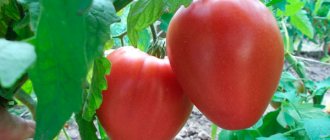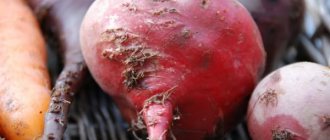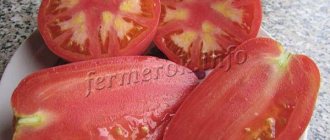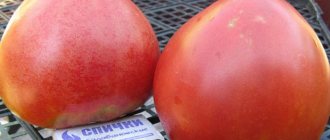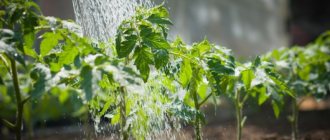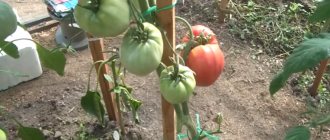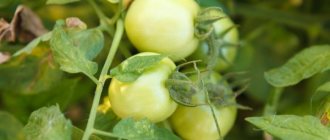Beets are very popular. Without this root vegetable it is impossible to prepare some popular dishes. Vegetables are grown in every summer cottage; Mulatka beets are an excellent productive variety that is suitable for growing in open and closed ground.
Growing beets is not new for our summer residents, but it is not always possible to obtain large yields. The fact is that this root crop, like other plants, has its own characteristics of growth and development, and the individuality of the variety should also be taken into account. Mulatto beets are a domestic variety that is most suitable for growing in our climate.
Features of the beet variety “Mulatka”
The description of mulatto beets from the manufacturer indicates that this variety is mid-season. From germination to ripening, it takes from 120 to 125 days. During this period, root vegetables reach a weight of 180-360 grams and can be used in preparations or cooking, as well as stored for winter. The beets of this variety are round in shape, burgundy in color, without rings. The pulp of the root vegetable is tasty and sugary. The variety is valued for long-term storage.
Fact. From one square meter you can collect from 4-6 kg of root crops of the Mulatto variety.
Main characteristics of "Mulatto":
- low maintenance requirements;
- resistance to the appearance of arrows;
- possibility of long-term storage of the product from autumn to spring;
- juicy, sweet pulp;
- During heat treatment, beets of this variety do not lose color.
History of the Mulatka beet variety and its photo
Mulatto beets - a mid-season table variety of domestic selection
Mulatto is a mid-season variety bred by Russian breeders in the late 80s. Due to its low maintenance requirements and a significant number of positive properties, this beet has become widespread in other countries. Today it is intensively grown in Russia, Moldova, and Ukraine. The increasing popularity of the variety is also facilitated by the high commercial qualities and good keeping quality of root crops.
Features of cultivation
For good beet growth, neutral, slightly acidic, loamy or sandy soil is suitable. If the soil has high acidity, it is deacidified by adding wood ash (a three-liter jar of the substance per 1 sq.m.) or dolomite flour (600 grams per 1 sq.m.). The soil is dug up to 25 cm and left until spring.
For rapid germination, beet seeds are soaked in warm water with the addition of manganese or a biostimulant. During this process, the seeds should not be allowed to dry out completely. After two days, the seeds are dried a little on thick cloth and sowing begins.
How to choose a beet variety for a specific region
The climate in the region is the first thing to consider when choosing a beet variety or hybrid. Selection does not stand still; varieties have long appeared that are specially adapted for the Urals, Siberia, and other areas with a sharply continental climate that is not very suitable for gardening. Those living in the southern subtropical regions are luckier. When choosing, they can focus solely on taste, yield, shelf life, and the presence of immunity to certain diseases.
Choosing the most suitable beet variety is not an easy task, especially for a novice gardener.
In central Russia, you can also plant almost any beet. Summers there are quite warm and the climate is moderate. Not only early varieties have time to ripen, but also late-ripening ones (their root crops form in September or even October). Winters here are most often not severe, so autumn sowing is also possible. Beet seeds are planted in late autumn, and they sprout in early spring.
Read more: Bluefry plum variety description
Among the early ripening varieties, Pablo and Bordeaux are the most popular among gardeners living in the European part of Russia. The time-tested Cylinder does not lose ground either. For those who love sweet beets, Regala is suitable. Of the medium-ripening varieties, Egyptian Flat and Podzimnyaya receive invariably positive reviews; the late variety Odnorostkovaya is valued for its excellent keeping quality.
In the Krasnodar region, Stavropol region, Black Sea region and Crimea, varieties that are distinguished by high yields are most often planted. The mild, warm climate makes it possible to achieve the stated indicators. Gardeners also focus on taste. The most popular varieties here are Nosovskaya Ploskaya, Gribovskaya Ploskaya, and Mulatka.
Summer in the Urals is characterized by unpredictability in terms of weather. It often comes out quite cold. Therefore, it is better to play it safe and plant early varieties, for example, Smuglyanka, Egyptian flat. They ripen already in July-August, but the root crops are quite large. Of the mid- and late-ripening varieties, only cold-resistant ones are suitable for cultivation in the Urals, which will not be damaged by quite likely early frosts. The best among them are Slavyanka, Barynya, and Detroit.
Cold-resistant beets are also planted in Siberia and the Far East. Summer there is short and quite cool. There are varieties specially adapted for these regions. For example, Siberian flat, Northern ball. With proper care, they are not inferior in yield and taste to other varieties. A distinctive feature is very good keeping quality.
Choosing the right beet variety is the key to a bountiful harvest
One of the main criteria that a gardener focuses on when choosing is the ripening period of beets.
Early beets
Early varieties, when planted in early April, produce a harvest as early as July, and some even at the end of June. They do not differ in keeping quality; their taste cannot be called outstanding. The root vegetables are smaller than other varieties, weight varies from 200 g to 500 g. These beets are best suited for salads and making juices.
The high sugar content of root vegetables means they are suitable for processing. These beets are also very good fresh and for making juice. It can also be included in children's diets.
An ordinary miracle
A variety from the mid-season category. The taste of this beet is very balanced, the flesh is tender. Root vegetables are round or slightly flattened, weighing on average 300-450 g. Sugar content - 16.5-17.8%.
Ordinary miracle beets have a very balanced taste
A popular mid-season variety, specially bred for cultivation in Western Siberia and the Far East. The variety rarely suffers from cercospora blight, but for some reason the beet flea beetle has a special love for it.
Bravo beets suffer from beet flea beetle attacks more often than other varieties.
Root vegetables are almost round. The pulp is dense, but tender and juicy. Weight varies from 200 g to 780 g. The taste is excellent, the sugar content is very high (15.8–17.9%). The percentage of root crops rejected is no more than 2–8%. Productivity - 6.5–9 kg/m².
An early variety, however, it is also suitable for long-term storage. It is recommended to cultivate it in the Central region. Advantages include resistance to cercospora and flowering.
Kozak beets are resistant to cercospora blight and do not suffer from flowering
The roots are elongated, suberization is moderately pronounced. The weight of beets is 180–290 g, sugar content is 15.7%. The yield is not bad - about 7 kg/m².
Mulatto
The most suitable regions for cultivation are the Volga region, the Black Sea region and the Far East. The variety is widely used in cooking, but is also suitable for long-term storage. Mulatto is a mid-late beet. The harvest is harvested 125–130 days after seed germination.
Mulatto beets - a popular mid-late variety
Root vegetables are almost round. Suberization is absent or very weak. Average weight - 160-360 g. Sugar content is very high - 14.2-14.6%. The percentage of defects depending on care is 2–18%. The variety is valued for its keeping quality and transportability, not only by amateur gardeners, but also by farmers. It is also little susceptible to sudden temperature changes.
The best table beet varieties are distinguished by their balanced taste. They are suitable for fresh consumption.
Rival
Medium ripening variety. Valued for its high yield and excellent taste. Small dark red root vegetables with a diameter of only 4–6 cm and a weight of 200–300 g. The pulp is very juicy and tender. The variety is demanding when it comes to watering. Productivity is average - 4.5–7 kg/m².
To obtain a bountiful harvest, Rival beets need to be properly watered.
Andromeda F1
Early variety. The state register recommends for cultivation in the Black Sea region. Single-germ hybrid. The root vegetables are cylindrical, up to 6.5 cm in diameter, very large - more than 680 g. The pulp is very juicy, cooks easily and quickly, and does not lose color during heat treatment. As a disadvantage of the variety, susceptibility to diseases is noted - root beetle, powdery mildew, cercospora blight, all types of rot. This variety is also sensitive to cold. A characteristic feature is the inability to accumulate nitrates.
Andromeda F1 beets cannot boast of good immunity
A medium-ripening variety that very successfully combines the excellent taste of root crops with shelf life and high immunity. The root crops are cylindrical, reaching a mass of 320 g. Almost two-thirds of the beets stick out from the ground, this is normal. Productivity is approximately 7 kg/m².
The root crop of the Kedri beet sticks out of the ground by almost two-thirds
Opolski
Achievement of Polish breeders. Mid-season variety. In Russia, it is recommended for cultivation in the Black Sea region and the Central region. The roots are elongated, weight varies from 160 g to 440 g. They are half immersed in the soil. The variety does not suffer from Phoma blight, but can become infected with Cercospora blight. Productivity - 2.5–5 kg/m².
The greatest danger to Opolski beets is cercospora blight.
Black woman
Recommended regions for cultivation are the Volga region and the Far East. Medium ripening variety. Root vegetables are spherical, suberization is weak. Sugar content is 9.7%, but this does not affect the excellent taste.
Negro beets are not particularly sweet, but this does not affect the taste
The cultivation of this crop is carried out according to some extremely simple rules. The seeds of the Mulatto variety are sown in April. Many gardeners are accustomed to immersing planting material directly into the ground. But, as the practice of many summer residents has shown, growing beets using seedlings will be the most successful.
Read more: How to properly form grape bushes: diagram, forms
When cultivating this plant, it is recommended to choose the site wisely. Beetroot of this variety loves fertile and loose soil, in which the acidity level will be weak or neutral. It is recommended to prepare the soil in advance, starting in September. The area is weeded, dug up, fertilized and disinfected.
Before planting, Mulatto beet seeds are selected. It is recommended to soak them in a weak solution of manganese.
Mulatto beets usually produce a large harvest
“Mulatto” is a beet variety that is extremely easy to grow. Any gardener can cope with its cultivation. At the same time, the variety guarantees a bountiful harvest.
How to plant beets
Planting root crops of this variety begins as soon as the soil temperature warms up to 6 degrees, and the average air temperature is +10 - +12 degrees. In the Moscow region and the middle zone, you need to look at the actual weather and the network of beets when the frosts pass.
Beets are planted in rows, the seed planting depth is approximately 2-3 cm. Enough space must be left between the rows to ensure good lighting. Experts recommend placing rows at a distance of 45-50 cm from each other. A distance of about 10 cm is left between the seeds; for the first weeks after germination, with this method, the beds do not need to be thinned. After planting the seeds, the soil is well watered. To reduce moisture evaporation, the area is covered with film or agrospan.
Growing seedlings
Already germinated beet seedlings of this variety are planted in the ground. Planting seeds directly into the ground is possible, but it will not give a large harvest, and besides, the growing time will increase by up to 25 days. And when planting seeds in the ground, it is necessary to subsequently periodically thin out the vegetable sprouts.
Growing seedlings for planting is very simple.
- For seedlings, soil of a certain composition is required, it is commercially available. But you can make it yourself. Its composition: a mixture of half a part of sand is made, with 1 part of ordinary soil, 2 parts of peat and 1 part of rotted compost or humus. And also for each bucket of the mixture you need to add 50 grams of wood ash. Next, the result of mixing must be steamed in a double boiler for about 60 minutes.
Read more: Ataman grapes description of the variety its characteristics and features
- A layer of germination mixture is poured into a deep cuvette and leveled.
- Beet seeds are placed on top of it. It is advisable to use germinated seeds - this will give a greater chance of germination, especially since you can immediately cull the bad ones. Before planting, it is also advisable to treat the seeds with fungicide and manganese - this will save the fruits from various diseases characteristic of this vegetable.
- Cover the seeds with a layer of the prepared mixture to a height of 1.5 centimeters and tamp down a little so that the soil does not wash away when it is spilled with water.
- Water, making sure that the seed does not float.
- Transfer the prepared cuvette with seeds to a well-lit and cool place. Transfer it after covering it with either a transparent bag or glass. The optimal temperature balance for germination is 18… 20°C.
- As soon as the first shoots appear, it is advisable to lower the air temperature to 14... 16°C.
- When the first cotyledon leaves appear, the plant is picked, that is, in other words, transplanted from a small to a large container. If a large and deep ditch was initially used, then there is no need for picking. If you still use picking, then the soil for it is the same as for the original seedlings, but a tablespoon of nitroammophoska is added to it for each bucket of the mixture. After picking, it is necessary to water the seedlings. If picking is not carried out, then if the seedlings are too dense, they are thinned out. The parts that were removed are seated additionally.
- To prevent the stem from stretching, a week after picking, you need to move the seedlings to a greenhouse, first covering them from direct exposure to the sun.
- Once every two weeks you need to feed the plant, for which you use liquid fertilizer containing nitrogen, phosphorus and potassium.
Seedlings are planted in the ground from the second half of April. Reading the reviews, you can see: many gardeners have noticed that for planting it is enough for the soil to warm up to 10°C. As for the soil itself, this variety loves loose soil, in which the amount of sand is greater than the amount of clay. But the soil must also receive a sufficient amount of moisture and not have a high acid level. Seedlings are considered ready for planting when they already have true leaves.
So, what is needed for planting: for the beds on which “Mulatto” will grow, a well-lit, sunny place is selected. This is done to ensure that there is not even the slightest shadow, as it will lead to a drop in the harvest. The soil for planting should be saturated with minerals; the variety loves highly fertile soil. For each square meter of soil, 40 grams of mineral fertilizers are added, which contain nitrogen, potassium and phosphorus. And also for each m², add at least three kilograms of well-rotted compost or pure humus.
Planting is done in cloudy weather, even if there is light rain. If the weather conditions for planting are always hot and dry, then after planting you need to cover the seedlings with dense material for a couple of days until they take root. The planting itself should be done in case of heat in the evening.
Holes are dug in the garden bed to such a depth that seedlings can be placed in them without bending. The seedlings are placed there accordingly, covered with soil and immediately watered. Watering is also done daily until the seedlings take root and the weather is hot and dry.
Care
Mulatto, like other beet varieties, needs timely watering and weeding. Using mulching, you can create a favorable climate in beet beds. In case of drought, this will help retain moisture; the plantings will not need to be loosened, fertilized or weeded. When there is a month left before harvest, the beets are not watered. Beets are harvested on a dry, sunny day, after allowing the roots to dry thoroughly.
Advice. Not many gardeners know that salt has a beneficial effect on the growth of beets. Moreover, watering with salt water promotes the formation of more sugars in root vegetables. Add a glass of salt to a 10 liter bucket, stir well and water the plantings.
Preventing problems
As a preventive measure, it is necessary to follow the rules for cultivating beets. To prevent the appearance of aphids and stink bugs, observe crop rotation, get rid of weeds in a timely manner and dig up the soil. Prevent the occurrence of beet flea beetle by treating the soil with wood ash. The likelihood of developing powdery mildew will disappear if you remove plant debris from the site in a timely manner and follow the principles of crop rotation.
Top dressing
The plant is regularly fed to get a rich and healthy harvest. Beets especially love organic fertilizers. After the first thinning, add 10 grams of potassium chloride and superphosphate, as well as 5 grams of ammonium nitrate per square meter.
A solution made from mullein or bird droppings is suitable. Twelve liters of solution will be required for 10 square meters of planting. You cannot combine two types of fertilizers. As soon as the seedlings grow to the point that their leaves come into contact with neighboring plants, another feeding is carried out. Wood ash is scattered over the bed (one glass per 1.5 square meters), after which the earth is watered.
Other care
After watering, the soil must be loosened to avoid the formation of a soil crust. The procedure will help air penetrate more easily to the roots, which will develop more actively with free access. Another important maintenance procedure is weeding, which removes all weeds that interfere with the development of beets.
Harvest and storage
The harvest is harvested before the first frost. To begin with, dig up the tubers with a pitchfork and remove excess soil from them. Using a sharp knife, cut off the tops. Fruits that do not show signs of rotting or damage can be stored. High-quality root vegetables are laid out in boxes or containers in several layers, separating them from each other with shavings or sawdust. Store the crop at temperatures from zero to two degrees.
Our website contains information about other popular beet varieties: “Vodan F1”, “Boro”, “Kestrel F1”, “Pablo F1”, “Bordeaux 237”, “Detroit”.
Healing properties
Boiled or boiled Mulatto beets have a mild diuretic effect, relieve spasms of internal organs, and have a general strengthening effect on the entire human body. Due to their high fiber content, beet salads are used for chronic constipation. For preventive purposes against diseases such as thrombophlebitis, arteriosclerosis and anemia, fresh beet juice is used.
You may be interested in: Favorable days for sowing beets for seedlings in 2021. Planting beets in open ground with seeds. When to plant beet seeds in open ground.
Doctors recommend beets as a dietary product for obesity, diabetes, and hypertension. Recently, experts included beets in the list of foods that prevent the development of cancer cells.
Growing
Growing table beets in open ground requires having certain knowledge and awareness of the nuances of cultivating the vegetable.
Purchasing and preparing material
You can purchase seeds of the Mulatto variety everywhere in gardening stores or online. The cost of a two-gram bag of seeds varies from seven to twenty rubles, depending on the region of residence.
Before sowing in open ground or in a container, the seeds are prepared so that seedlings appear earlier. To do this, mix a solution of ten liters of water, a teaspoon of baking soda, the same amount of superphosphate and wood ash. The planting material is filled with liquid for exactly two hours, after which it is washed under running warm water and placed in a dry cloth.
Sowing time
Beets can be planted in open ground around April or May. The main guideline is the soil temperature: the ground should warm up to ten degrees at a depth of ten centimeters.
Site selection and soil preparation
Advice! If the beets are placed in a darkened area, the color of the root vegetables will be pale and light.
The variety requires a high level of illumination, so an open area with unhindered access to sunlight is selected for beets. "Mulatto" can grow in almost any soil, but it cannot be cultivated in swampy areas. You should pay attention to the acidity of the soil: beets feel comfortable in soil with a low or neutral pH.
When choosing a site, be sure to use the principle of crop rotation. The best predecessors for beets are: onions, tomatoes, potatoes, cucumbers. The place where cabbage and carrots used to grow is not suitable. It is recommended to plant onions, radishes, beans and cucumbers next to beets. Spinach, leeks, potatoes, celery and corn are not suitable as neighbors for the crop. You can return beets to their original site only after three or four years.
Prepare the soil for planting in the fall. To begin with, all the weeds are pulled out, then the ground is dug up and fertilizers are added: ten kilograms of compost, humus or manure for every square meter. 400 or 500 grams of slaked lime are placed in soil with a high level of acidity.
Planting process
There are two ways to sow beets in open ground: single-line or double-line. The one-line method involves planting in lines located forty-five centimeters apart from each other. The second method involves constructing two lines at a distance of twenty-five centimeters from each other and creating another pair of lines with an interval of fifty centimeters from the previous group.
The sequence of sowing actions is as follows:
- water the furrows well, wait until the moisture is completely absorbed;
- the seeds are planted in the ground, maintaining a distance of five or ten centimeters, lowering them to a depth of three centimeters;
- planting material is covered with soil;
- Having retreated ten centimeters from the plantings, weeding is carried out with an ordinary hoe so that oxygen can easily reach the planted beets.
Important! Each seed will produce several plants, so thinning the plantings cannot be avoided. As soon as the sprouts have two leaves, thinning is carried out, leaving a two-centimeter distance between the seedlings. The second time this procedure is resorted to after the development of four or five leaves.
Content temperature
The optimal temperature for germinating seeds is 20 degrees , although they begin to germinate at lower temperatures. During growth and development, beets feel comfortable if the air warms up to thirty degrees.
Watering
Beets are watered about twice a week, depending on the condition of the soil. Drought and excess moisture negatively affect the condition of tubers. In the first case, they will become hard and bitter, and the shelf life will be reduced. An excess of liquid provokes watery fruits and rotting of the root system. For irrigation, settled water heated to air temperature is used. Cold water negatively affects the development of the plant.
Advantages and disadvantages
Beets help diversify the daily diet; this root vegetable is cheap and accessible to everyone. Beets are easy to grow yourself, without a lot of time and labor. In addition to its excellent taste, mulatto contains many vitamins and microelements, without which the normal functioning of the human body is not possible.
As a disadvantage, we can note the content of oxalic acid in beets, but this component is contraindicated for people suffering from impaired functioning of the kidneys and bladder. For peptic ulcers of the stomach and intestines, beets should also not be consumed. An allergy to this product is a reason to refrain from eating beets.
In general, beets are a safe product that has been on our tables since childhood. If you do not abuse it and eat beets in moderation, then this will only be beneficial for our body.
Important! When buying root vegetables, you need to know that beets, like a sponge, absorb heavy metal salts from the soil, therefore, like other vegetables, beets should be purchased only in areas with a favorable environmental situation.
How to care?
The variety does not require special care. The only thing you need is to periodically weed the plants and keep the soil loose. It is also necessary to fertilize the vegetable. To do this, knowledgeable gardeners recommend using mullein, diluting it in the proportions of 1 serving of mullein to 6 servings of water. This natural fertilizer contains minerals that are necessary for producing large, juicy and sweet beet roots.
You can also use chemical fertilizers for feeding, but you must remember that at the beginning of the growth of the vegetable it needs nitrogen, so nitrogen fertilizers are used at the beginning of the plant’s development. When the beet leaves come together, they switch to fertilizing with fertilizers containing phosphorus and potassium.
Weeding
Fertilizer
There are several recommendations from agronomists regarding growing beets.
- In order to raise the sugar level in a vegetable, it must be watered twice a season with a salt solution (2 tablespoons per bucket of water) or a solution of sodium nitrate (1 tablespoon per bucket of water).
- To prevent voids and plugs from forming in the fruits, it is necessary to fertilize the plant with boron several times per season. Fertilizing must be done on the plant leaves themselves, and it must be done in cloudy weather, using a solution of two grams of boric acid per bucket of water.
Possible diseases and pests
Diseases
- root beetle The disease most often affects plants during the germination period. It develops due to the content of pathogenic microflora on seeds or in the soil. A constriction forms on the stem of the sprout, after which the root dies;
- cercospora blight The disease is caused by a fungal infection that develops in beet leaves. As a result of its influence, the leaf blade becomes thick and the color changes to olive-brown. In rainy weather, a gray coating is visible in the spot area; these are fungal spores. When there are many spots, the leaves die. Sources of infection can be seeds or plant debris from diseased plants left over from the previous season;
- fomoz. This disease occurs when there is a lack of boron in the soil. The fungus attacks weakened parts of the root system, causing dark spots to appear. Root crops affected by this disease should not be stored.
Pests
- beet aphid. The leaves affected by these insects turn yellow, the plant withers and practically does not flutter. The root system begins to rot and the beets can be easily removed from the ground. You can see mold on the soil around the plant;
- beet flea beetle. Small insects are black with a bronze tint. During the winter they remain under plant debris, between the walls of the beds and the soil. In the spring, the bugs are very voracious, and there are ways to completely destroy young plants;
- common beet weevil. The pest is small in size, only 1.5 cm, black in color with gray scales. In winter it lives in the soil, with the arrival of spring it begins to feed on weeds, later it switches to beets, eats leaves and bites the stem.
How to grow
Growing Mulatto beets is a simple process, the main thing is to follow all agricultural practices and rules. The crop is planted using seedlings or without seedlings. The first is suitable for regions with unpredictable climatic conditions, the second is appropriate in areas with warm weather and fertile soil.
Planting by seeds
Before planting seeds, be sure to disinfect the seed using a solution of potassium permanganate or aloe juice. Place the seeds in a fabric bag, then lower it into the prepared liquid. Disinfection reduces the risk of developing diseases in the future and also increases the plant’s immunity.
The next stage is preparing the land. Beets are an unpretentious plant, but it is better to plant them on a dry and loose plot of land. At the end of October, dig up the future beds, remove all debris, and burn the weeds. With the arrival of spring, dig up the ground again, and then add river sand or lime to the beds. This is necessary in order to make the soil looser and reduce its acidity.
Once the beds are ready, make small grooves in the soil at a distance of 30 cm from each other. Place disinfected seeds in them and sprinkle soil on top, watering them generously with warm water.
Important! Experienced farmers advise using rainwater for irrigation. Its composition is optimal for watering young seedlings and does not contain pathogenic microorganisms. To easily collect rainwater, simply place a couple of empty tanks on your property. If there is a house nearby, build waste surfaces above the containers.
Planting seedlings
Seedlings help sprouts to quickly take root in the beds and withstand frosts and other unfavorable conditions without problems. For seedlings you will need a container. It can be anything: milk or kefir bags, wooden boxes, flower pots and even plastic cups. Before planting, do not forget to thoroughly wash the container, dry it and treat it with a weak solution of manganese.
Prepare the soil for seedlings in advance. Some gardeners prefer to use a mixture of garden soil, peat and humus. Other gardeners purchase special soil “Krepysh” or “Universal” soil. The main thing is that the soil is clean, free of dangerous microbes, larvae and foreign debris. To be sure of the quality of the soil, gardeners advise disinfecting the soil using an ash solution.
Seedlings are prepared 3-4 weeks before planting beets in the ground. Plant the seeds at a distance of 2 cm from each other. After sowing, sprinkle with a thin layer of soil and water with a small amount of water, approximately 1 liter per 1 kg of soil. Then the seedlings are covered with film or thin glass and placed in the warmest and brightest place in the house. As a rule, this is a window sill.
Important! Beet seedlings require attention and care. Water the sprouts every 7 days, preferably in the morning or evening. Use only filtered warm water. After 2 weeks from the moment of planting, the seedlings are fed with liquid bird droppings or nettle infusion. For more accelerated development, the growth stimulator “Kornevin” is added.
Care
Timely and competent care is the key to a tasty, rich harvest. When watering, be guided by weather conditions. If the summer is hot and humid, water your beet beds every 7-10 days. If the weather is dry and there is no rain, moisten the soil once every 5 days. Use only rain or settled water. To prevent sunburn, moisten the soil early in the morning or after sunset.
After watering, a thin crust may form on the soil. It makes it difficult for oxygen to reach the roots. Therefore, the beds need to be loosened regularly. Loosen the soil every 7 days, combining with the removal of weeds. Weeding maintains cleanliness in the beds and conditions for normal development of beets.
Mulatto beets need mineral supplements and organic fertilizers. This can be root feeding, for example potassium chloride or superphosphate, as well as foliar feeding - pollination of bushes with soap or onion solution.
In total, during the ripening period of the crop, 3-4 fertilizing is carried out, which not only protects the beds from diseases and pests, but also improves the taste of the fruit.
Features of cultivation and possible difficulties
Be careful with nitrogen fertilizers, as their excess causes an increased level of nitrates in the fruits. Apply fertilizers containing copper, boron and molybdenum in a timely manner. Otherwise, the quality of the fruit will noticeably deteriorate.
If beet leaves become light in color, immediately feed the plants with potassium supplements. There are situations when the tops turn red. This means that the plant does not have enough sodium or the acidity level in the soil is exceeded. To eliminate the problem, gardeners advise sprinkling the beds with ash and watering the bushes with salt water.
Interesting! In ancient Rome, beets were considered a symbol of quarrels. However, people still actively ate root vegetables, tops and even the roots of young plants. Before this, the Romans soaked them in water and sprinkled them with pepper.
Advice from experienced gardeners
To increase the quantity and quality of the harvest, experienced gardeners recommend using special rules and growing secrets.
Important Recommendations:
- The best predecessors for beets are cucumbers, potatoes, onions and tomatoes;
- do not plant the crop after carrots or other beet varieties;
- for more sugar, water the beds with a salt solution at the rate of 1 tbsp. l. for 10 liters of water;
- beets love moisture - per 1 sq. m uses about 20 liters of water;
- If possible, use a drip irrigation system. It saves water and directs it directly to the root, bypassing the stems and leaves;
- a month before harvesting, try not to over-moisten the soil;
- To speed up growth, cover the beds with vermiculite or peat.
Diseases and pests
If not properly cared for, the crop may develop fungal infections or viral diseases.
The most common of them are:
- Powdery mildew appears as a white coating on leaves and stems. The causes of the disease are high humidity, contaminated soil, and untimely weeding of the beds. As a preventive measure, water the bushes with a solution based on aloe juice, follow the rules of crop rotation. If powdery mildew has already appeared in the beds, treat the affected areas with ground sulfur.
- Phoma primarily affects the leaves, covering them with yellow spots. After 2-3 days, the disease spreads to root crops, and the beets begin to rot. To prevent Phoma, spray the garden with a solution of Bordeaux mixture. For treatment, it is necessary to treat the beds with 0.4% copper oxychloride.
Among the pests, beet midges and aphids attack the beds. Insects settle on plant leaves and suck vital juice from them. For this reason, fruit development slows down and taste deteriorates. For prevention, gardeners advise spraying the beds with a soap solution, loosening them in time and removing weeds.
Another dangerous pest is the mole cricket. The insect lives in the ground and does not die even in winter at low temperatures. The mole cricket lays eggs and makes nests under the beds. The larvae begin to gnaw the roots of the plant, which leads to metabolic disorders. Dry eggshells or spraying the beds with a solution of copper sulfate will help get rid of mole crickets.
Proper watering of beets
Water the crop depending on weather conditions. It is important that the soil is moderately moistened. Overmoistening and lack of moisture equally negatively affect the formation of beet fruits.
Approximate schedule for watering beets:
- 2-3 times a week, when the soil does not stick to your hands and when the coma is well formed;
- once a week, when the soil sticks to your hands;
- once every two weeks, when droplets of water appear when pressing on the ground.
To water the soil, use a simple watering can or the drip method. It is necessary to water exactly at the root, avoiding water getting on the leaves.
The procedure is preferably carried out in the evening. The water must be settled.
Watering is suspended 14-21 days before harvest.
Characteristics and description of the table variety with photos
The variety is characterized by marketability of 81-98%, high yield (470 c/ha), rounded root shape (no suberization of the head), oval, green, slightly bubbly leaves with weak wavy edges, mid-season ripening period (125-130 days).
Beets have red, uniform, juicy pulp. The fruit has excellent taste and has a universal purpose (cooking, storage). The crop is resistant to pathogens and is grown in the Central, Volga-Vyatka, Central Black Earth, and Far Eastern regions. Mulatto beets are a mid-season variety with a juicy taste and attractive appearance.
Beets are rich in beneficial properties due to the content of proteins, carbohydrates, mineral salts (potassium, phosphorus, calcium, iron), microelements (fluorine, iodine, boron, zinc, fluorine, etc.). This crop is medium in size, has light green oval leaves, with a smooth plate with wavy edges. The axial root is purple.
Mulatto can be grown as a “compactor” for planting onions, bush zucchini, cucumbers, and early cabbage.
A rich red-burgundy fruit weighing from 160 to 350 g, with juicy and tender pulp in cross-section, has a smooth and even surface, rounded in shape. There are no cylindrical rings in root vegetables. 1 sq. m allows you to collect about 5 kg of sweet fruits.
Next you can look at the photo of the vegetable:
Video about the main characteristics of beets of the “Mulatka” variety:
Collection and storage
Harvesting must be done before frost begins. Round root vegetables are dug up with a pitchfork, cleared of adhering soil, and the tops are cut off (a 1 cm long petiole remains). Next, the harvest is sorted - only whole, not rotten fruits are suitable for storage.
Beets are placed in boxes or bags with the tops facing out. The layers are sprinkled with sawdust, shavings or sand in a 4 cm layer. Optimal storage conditions are a temperature of 0-2 degrees and a humidity of about 90-95%, good ventilation. If storage is carried out in a bag, then the neck is not tied.
If it is not possible to store the crop in the cellar, then it can be stored in pits 1 m deep and 2 m wide, at the bottom of which boards are laid at a height of about 20 cm from the ground. In this case, the beets are stacked around bundles of straw installed vertically in the center. Next, it is covered with a soil layer 50 cm thick and additionally covered with brushwood or straw. Another layer of soil is laid on top.
